
![]()

|
|
|
|
|
|
U.S. Articles of Interest
Page 2
|
Masonic Sword (Item USARTICLES 2-3 & MASON 1-2) |
||
DESCRIPTION: This is a beautiful example of a dress ceremonial sword of the Freemason sect of “Knights Templar” Atlanta Commandry No. 9. It was sold by the McLilloy Co. of Columbus, Ohio and belonged to a Brother Ronald A. Limbert .We would venture to say that the sword dates in the 1930’s or earlier. It was an expensive item in its day and the owners of such a prestigious item treasured it most highly. The sword is in beautiful condition with the imitation ivory grip and all the various symbolism of the craft. It has a leather case but the name inside is not Mr. Limbert's name and we believe it has a case given to Brother Limbert by another member possibly willed to him as often happened with the membership. This is a prime example of the sword of the 32nd degree of Masonry. The Knights Templar trace their origin back to shortly after the first Crusade. They were called the poor Knights of the Temple of King Solomon. Their sacred mission was to protect pilgrims on their journey to visit the Hoy Places. Today the Masonic order of Templar seek to honor these Knights of yore. PRICE: SOLD |
||
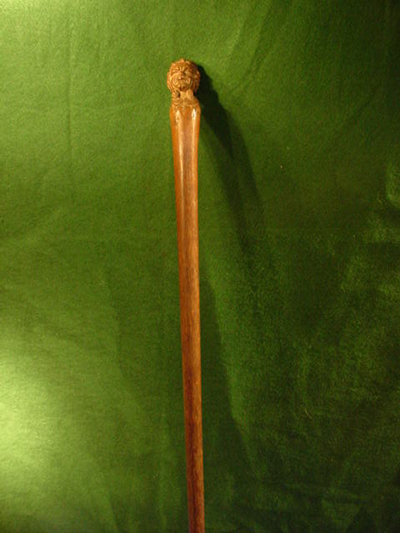 |
Folk Art Cane from 11th Century Georgia; |
|||
DESCRIPTION: The walking stick or cane is hand carved with an artist's conception and depiction of “Old Scratch.” This was a Southern colloquialism for the devil as indicated by the name of the character in the story “the Devil and Tom Walker” by Washington Irving. The story is very similar to that of the ancient German legend of Faust. It concerns a man striking up a deal with the devil. You can look up the story on the internet under the title. The stick is quite nice with the expert folk art carving by a mountain man up here in the rural mountain area of Georgia. The stick is about 30 inches long, probably hickory wood. A great piece of Rustic Americana. Note the devil's horns on the head. PRICE: $170.00 |
|||
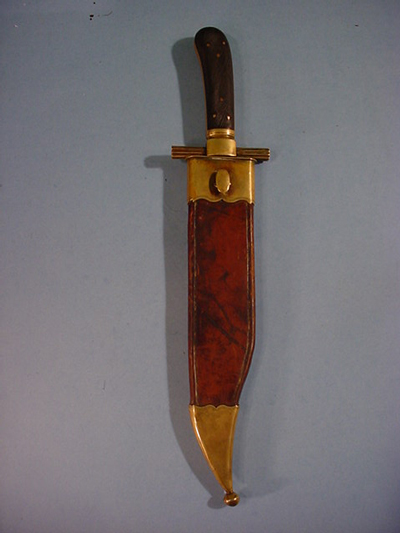 |
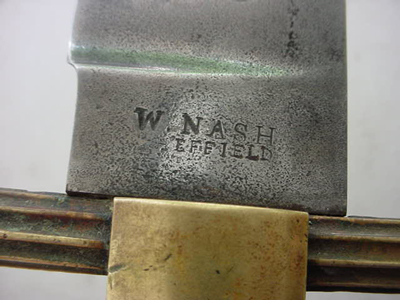 Maker's Name |
Massive Bowie Knife (Item USARTICLES 2-6) |
|||
DESCRIPTION: This is the Bowie knife of the American West in all it glorious saga and fame. This one is probably close to the knife designed and used by James Bowie (1796-1836). Jim was known for his famed Bowie knife and although he was a rather reckless adventurer, he is now immortalized as one of the true folk heroes of early Texas. Bowie was born in Kentucky and while still very young he moved with his family, first to Missouri then in 1802 to Louisiana, where he spent most of his youth. It was there that he first acquired a reputation for his bold and fearless disposition. In 1827, Bowie participated in a bloody brawl near Natchez, Mississippi where several men were killed and Bowie was severely wounded. After recovering the following year, he moved to Texas. In the Texas revolution, Bowie was a leading participant in the Battle of Conception and in the Grass Fight near San Antonio. He was in command of a volunteer force in San Antonio when William Travis arrived with regular army troops. The two men shared authority during much of the siege of the Alamo, which caused some personal friction, but pneumonia disabled Bowie, and he was confined to his cot at the time of his death on March 6, 1836 at the Battle of the Alamo. “Remember the Alamo.” I think we should all carry Bowie knives even now and remember the cold blooded massacre of the defenders of the Rights of Americans especially now! Old Santa Anna should be walking the “hot coals” even now! Lets secure that border! Bring home the troops and put them on the border (my opinion!). During Bowie's lifetime he has been described as “a clever, polite, gentlemen attentive to the ladies on all occasions. A true constant and generous friend. A foe no one dared to undervalue and many feared; slave trader, gambler, land speculator, dreamer, and hero.” Jim Bowie in death became immortal in the annals of Texas history. The bowie knife we offer here was like so many others of the period made in Sheffield, England. This one was by W. Nash, a maker of some reknown. It is not like the early crude examples made domestically; it is an excellent professional cutlery masterpiece finished in the finest materials that could be utilized, it has a fine checkered finish on the grip. We can’t tell if the grip is fashioned from horn or deep ebony wood. On the backside there is a heraldic style shield in silver. The blade shows much usage but you can still see the words “Arkansas Toothpick” and the maker's name. This was for personalizing but nothing is there. Perhaps worn off or possibly never there. This is without a doubt period original and much better looking and better made than the average example, A decidedly classic piece of “Westward ho! Americana. Jim Bowie would have loved this one! PRICE: SOLD |
|||
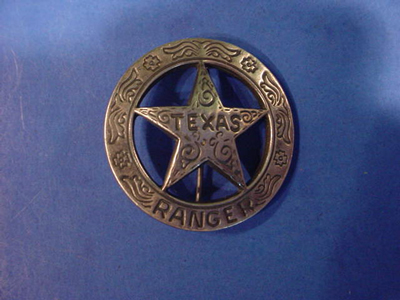 |
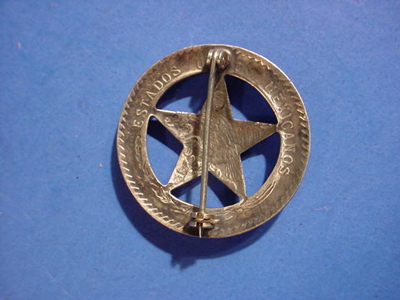 |
Badge of the Elite “Texas Rangers” Made from a Mexican Coin (Item USARTICLES 2-7) |
|||
DESCRIPTION: This is an original badge of authority of the famed Texas Rangers. When a recruit graduates from the ranger school he is issued a rather cheap tin star that from a distance looks like the one we offer here but on closer inspection, the resemblance ends abruptly. If the recruit follows years of ranger tradition he immediately goes to a jeweler who cuts and engraves a ‘Mexican Peso Coin’ to form a Ranger badge in pure silver. The new Ranger then has a beautiful badge that is not only reminiscent of 100 or more years of tradition but is twice as good looking as the issue badge. You can see the pattern of the Peso on the reverse of the piece. The age of the badge cannot really be determined since old Mexican coins are used by the jewelers but we feel this one is at least 45 to 55 years old because of its original source. This is not only a great looking keepsake, but a highly collectible relic of the old, but not so old, Wild West. The Rangers had a saying “No fella in the wrong can stop a fella in the right who keeps on a-comin’!” PRICE: SOLD |
|||
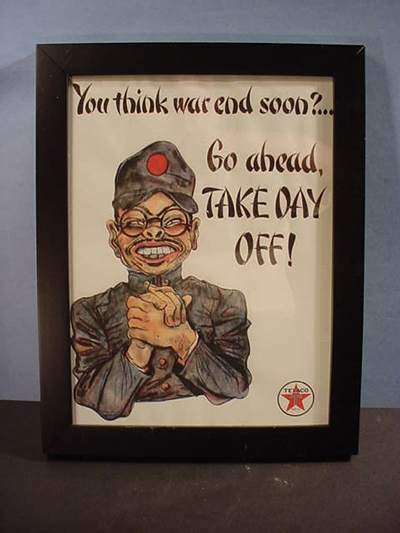 |
Anti-Japanese Poster Issued by Texaco (Item USARTICLES 2-8) |
DESCRIPTION: This is rather typical of the propaganda posters posted in factories producing war related products in WWII. It is, we believe, original and it has been nicely framed. Racist? Well, I guess it's alright to be racist after Pearl Harbor, right? The poster is 14" x 11" in measurement. A great piece of war propaganda. PRICE: $90.00 |
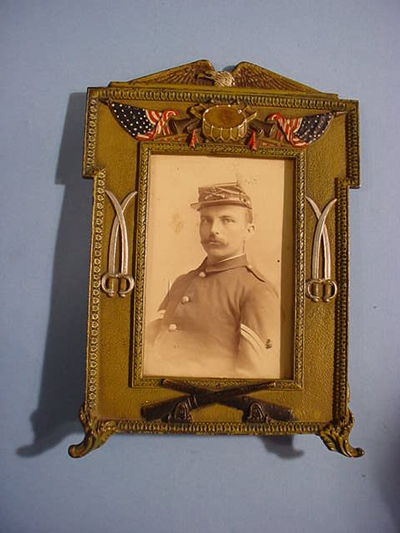 |
A Very Beautiful Frame and Picture of an American |
|
DESCRIPTION: This is indeed a great Civil War item although it pictures one of the Yankee invaders of our Dixie (We are in Georgia); however, it is still a part of history. Yes, he was part of the American Holocaust, a soldier (misguided) who was possibly drafted to take part in the Northern Aggression against the South whose soldiers fought in the 2nd War for Independence on American soil (the South was right!). Back to the framed soldier... From his hat insignia he is an infantryman of non-com. rating?? The frame is in brass with beautiful décor throughout. All the swords, cannon, drum, eagle, flags, are in high relief. The frame measures 9" x 6 ½". It has an ornamental folding hook in the back so one can place it on a table or fold it to be hung on the wall, very nice condition. But help us to get it out of Dixie! PRICE: $495.00 |
|
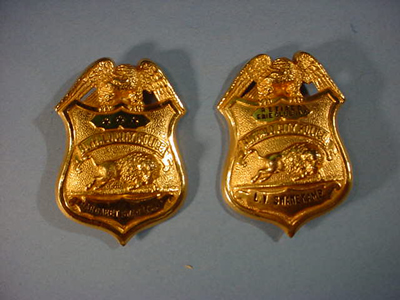 |
Buffalo N.Y. Police Retirement Badges (USARTICLES 2-11) |
||
DESCRIPTION: To badge collectors, the most elusive and most desirable Police badges to attain for years has been the Buffalo, N.Y. Police Badge because of its distinctive Bison (Buffalo) running across it. One of our advisors was a Buffalo Special Police Officer back in the 60’s and 70’s. He has consigned us two Buffalo retirement badges that are absolute gems. They belonged to a Police Dept. higher staff member by the name of L.V Swanekamp who like every Buffalo Police officer belonged to the Erie Club -- this was a patrolman’s benefit organization. His badge has the retired Erie Club identification at the top in a banner. His wife, Margaret Swanekamp, also worked for the Police Department and was issued the standard retirement badge with the three stars that always indicated retirement. The two badges are in pristine condition and certainly in police collecting, they are considered quite rare. PRICE: The set $289.00 (A bargain!) |
||
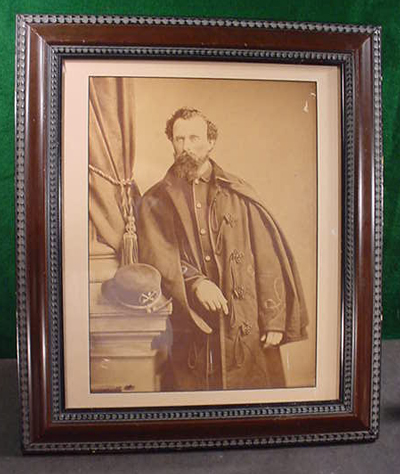 |
| Civil War Cavalry Officer (Original Photo) (Item USARTICLES 2-13) |
DESCRIPTION: Here is a great posed sepia tone photo of a Civil War officer. The picture with frame measures 18" x 21" while the actual picture is 11" x 15". There has been some controversy on this piece while all experts agree that it is 100% original, some say he is a dashing Confederate soldier but other opinions down here in Dixie say he is a stinking murdering Yankee invader but we at “Germania of Georgia” think he is one of the heroic defenders of this sacred Southern soil. In any case, it is a rare size and those crossed sabers tell us plainly what branch of the service he was in. The braid on the coat and cuffs seem to be very Confederate but I can’t say for sure. In any case, a great relic of the war of Northern Aggression, the second war for independence fought in our and for our land. PRICE: SOLD |
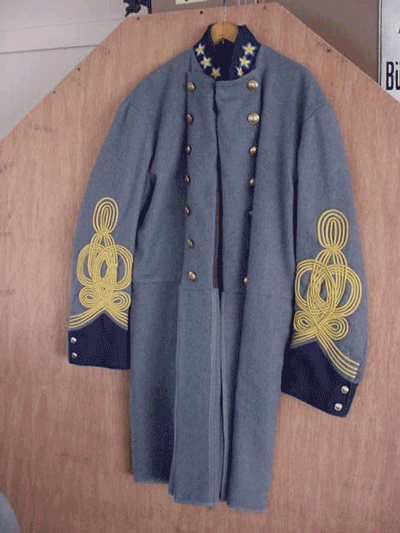 |
A Reproduction of a Confederate Officer Uniformcoat (Item USARTICLES 2-14) |
DESCRIPTION: This is a quality coat of the finest material and an accurate remake of the garment of a Colonel in the Confederate forces of the Army of Northern Virginia Joseph E. Johnston, Commanding. it could also be for the rank of General Gen. Robert E. Lee -- he wore something similar. Perfect shape, probably never worn. It will look great hanging on your hall tree. Sort of says that you support the correct side in the Great War of Northern aggression, The second war of independence fought in America. PRICE: SOLD |
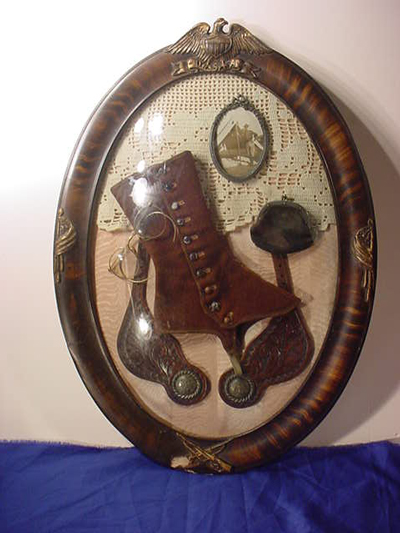 |
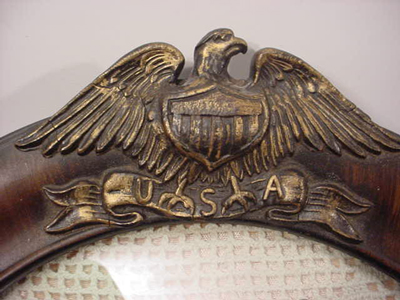 |
U.S. Calvary Group (Item USARTICLES 2-15) |
DESCRIPTION: This is a completely unique grouping put together by the widow of a horse soldier who served in the first World War. She had a period frame covered in glass with military and patriotic motif and inside she placed his spectacles, one of his ankle spats, change purse and some Mexican spur straps with silver roundels that are quite fancy. So here is a man's career in the service before you along with his picture. Also along with this group is the saddle bags that he kept after his retirement. They are in very good condition except for where he had to do a field repair where they started to separate. They are both marked U.S. as they should be for Army-issued equipment. A very nice historically important grouping in nice condition except for a bit of damage to the bottom decor of the crossed rifles (damage pictured above). PRICE: $285.00 for all |
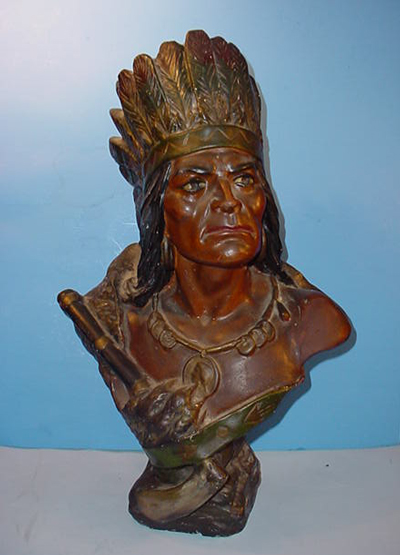 |
An Indian Bust Early Conception of the Red Indians (Item USARTICLES 2-16 & AMINDIAN 1-10) |
DESCRIPTION: This was a common thing in the 1870’s- 1890’s and almost every doctor’s office, general store, schools and especially tobacco shops would have one. These were several varieties of them but they all had the feather bonnet. If this was not evident then the average folks wouldn’t even recognize him as a ‘Red Indian.” This one has a war axe (tomahawk) and a bear paw glove. He has a government issued peace medal about the neck and this indicated that he must be a “good Indian”. The bust stands 22 inches high and 13 ½ across the shoulders. It is still covered with dust and has some minor chips here and there (never repainted). In the 1800’s mediums used to always have one of these in the home to act as a spirit guide to the occult world, being that he Indians were by nature great at tracking and guiding. Sometime these busts would have a name (Hiawatha) emblazoned on the plinth. In any case, this is a real piece of American history. PRICE: SOLD |
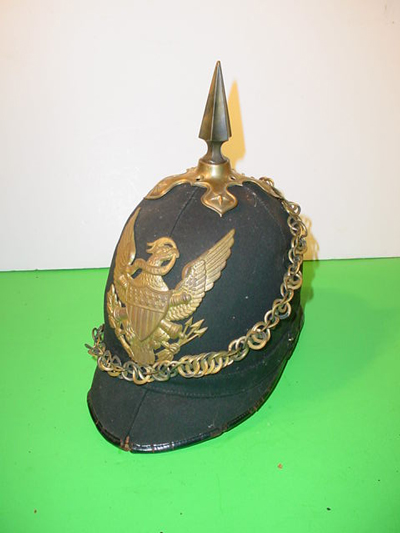 |
Model 1887 American Officers Spiked Helmet (Item USARTICLES 2-17) |
DESCRIPTION: Following the success of the Prussian Army during the Franco Prussian War 1870-1871, many nations including the United States began to use spiked helmets. These were modeled after those used by the Prussian and united German armies. The American version typically was dark blue and used as part of a dress uniform rather than on daily active duty. The 1902 artillery spiked helmet was almost identical. Both models were very resplendent looking when worn with the full dress blues. The one we offer here is in fair condition with a few small breaks in the brim front and rear. The label inside shows it to have been made by a N.Y. company and it was inspected in the year 1900 and issued to the N.Y.N.G (New York National Guard). Later companies of regulars were issued these sharp looking helmets throughout the country including most of the southern states militias and especially those in Georgia, Alabama and North Carolina. PRICE: $1,350.00 |
 |
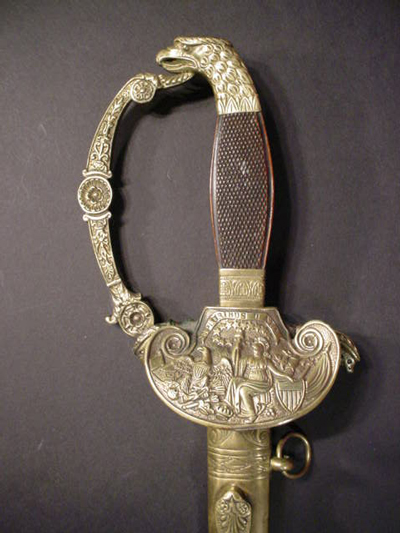 |
American 1840 Period Infantry Officers Sword (Item USARTICLES 2-18; ANTWEP 1-12) |
DESCRIPTION: This magnificent sword is very much like the one pictured on page 171 of the book “The American Eagle Pommel Sword" by E. Andrew Mowbray. The picture is of two swords of this type and the one on the right resembles the one we offer with a few differences. First instead of a wooden wire wrapped grip, ours has a beautiful mahogany wood grip beautifully checkered and in one piece. The eagle’s head we feel is of the F.W. Widmann style for sure and is the type V1. Comparing again to the picture in the book ours has a much more elaborate clam shell guard employing Columbia seated holding the staff of revolution and the American flag shield. Above her head are the thirteen stars for the original Colonies and beside her the American Federal eagle and below the eagle; you can see the crowns of empire with the staff of royalty. This represents the victory over British rule by the American Revolutionists. Battle axes and other weapons are seen in the background and the motto E. Pluribus Unum. The blade is in good shape except the bluing and gilding is pretty much gone. It has the usual engraved panoply of weapons in place on both sides. There is a stamped mark that looks like letters under the cross guard on the blade. The sword in its scabbard is three feet long. It is a very handsome piece, especially the clam shell guard that is possibly unique. Certainly the most patriotic motif that we have ever beheld. It may have been custom made for the bearer who must have been a true American patriot in an age where such things as patriotism meant something other than loyalty to one’s favorite football team or regular attendance at NASCAR. A great museum worthy specimen of an American classic sword. PRICE: $2,500.00 |
 |
 |
Wells Fargo & Company Commemorative Medallion (Item USARTICLES 2-19) |
DESCRIPTION: Here is a real rarity. It is an old solid silver medallion that commemorates an anniversary of the company. There is the date of 1852 on one side of a scroll and on the other all that still shows is 190?-. We assume this would be 1908 when the greatest expansion of the company was accomplished -- they now had 6,000 communities within their network and they were not only the originators of the Pony Express and delivery by the Iron Horse but now they were the bankers of the richest banking house in the nation. Obverse of the piece shows a stagecoach pulled by a horse team. Under this is a scroll with the legend - Wells Fargo & Company; under that a Pony Express rider on his route with the figure of a wild Indian trying to bring him down with bow and arrow. The reverse side it is very busy! At the top you see ships of the W.F. line, and under that a locomotive carrying the mail and then symbols that depict the tools of the trade (telegraph and security keys). Then another scroll that proclaims Express Banking at the bottom under some sort of company logo are electric volts and it says – Fidelity! The size is exactly the same as an American silver dollar and the weight the same. It is quite worn on both sides but the detail is easily made out. A rare piece of Americana. Probably impossible to find today. 1 ½ inches in diameter. PRICE: $175.00 |
 |
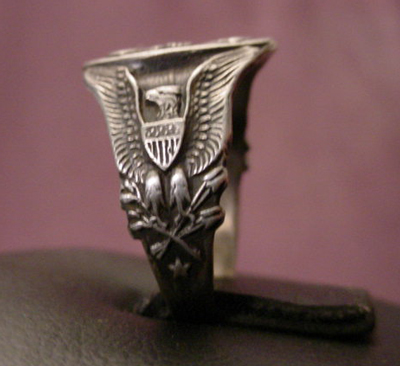 |
WWI Machine Gun Company Ring (Item USARTICLES 2-20) |
DESCRIPTION: Here is a WW I rarity. A silver ring from a machine gun company. It has two crossed Lewis machine guns. These were automatic machine guns of American design and widely used by both the British and American forces in WW I. It is visually distinctive because of a wide tubular cooling shroud around the barrel and a top mounted drum pan magazine. It was commonly used as an aircraft machine gun almost always with the cooling shroud removed during both wars. Production in the US was accomplished by the Savage Arms Company. The rings shank has the American eagle clutching arrows and the flag shield on its chest. It is in sterling silver and so marked inside. It is a size 10 and we also have one in size 11 and in our town there is an excellent jeweler who can size it for you in other sizes at $20 extra if needed. A very nice historical item in great shape. PRICE: $248.00 |
 |
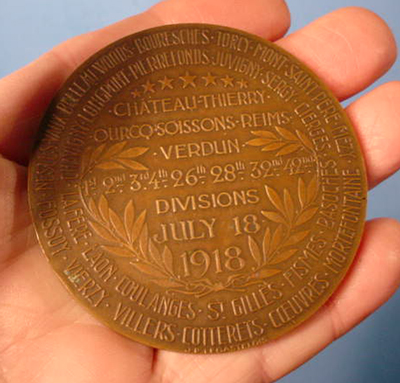 |
Bronze Medallion Commemorating the Battles Involving Various American Divisions in the First World War (Item USARTICLES 2-21) |
DESCRIPTION: This medallion very well struck was produced on July 18, 1918 and honored the 1st, 2nd, 3rd, 4th, 20th, 28th, 32nd and 42nd Divisions and the participation in the battles of Chateau-Thierry Ourcqsoissons, Reims. and Verdun. All along the edges of the reverse side are double rows of other battle sites where these divisions fought. The obverse side has a depiction of doughboys marching forward to battle with the flag bearer at the forefront. Airplanes soar overhead and underneath it says "For the Honor and Liberty of Nations." On the back it is signed J.P. Legastelois. 2-3/4th diameter. Remember this was the war to end all wars!!! But now we have perpetual war for perpetual peace. Quote: George Orwell in his great prophetic book 1984. PRICE: $150.00 |
 |
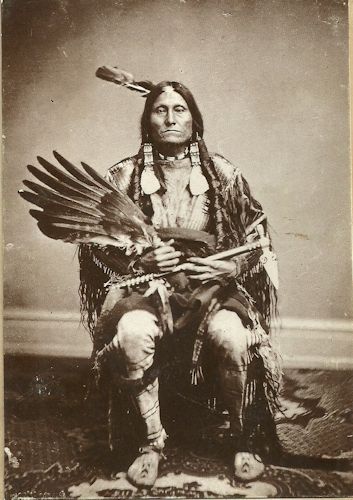 |
 |
Plains Indian Spontoon Pipe Tomahawk (Item USARTICLES 2-22 & AMINDIAN 1-11; ANTWEP 2-6) |
DESCRIPTION: Here is what I would consider the rarest of the rare. A genuine Spontoon Tomahawk. As we have said in an earlier article on this page these ‘hawks” were traded to the Indians of many tribal groups but this type was pretty much traded and used by the tribes of the Western Plains. This one has a stamp on its lade that says U.S. Government and this opens up several possibilities. Could the piece be one of numerous items presented to certain tribal members who served in or as scouts for the army? Or could the heads have been fashioned from other Government owned items such as rifle barrels? Although the metal heads were produced in the East, the wooden shaft was generally handmade by the warriors themselves and of course the brass tacks were invariably used as decoration. The blade of this magnificent specimen measures a huge 11 inches across from the pipe bowl to the lethal tip. The haft measures with head or blade 23 ½ inches long. The portion just below the head and also at the bottom-most section is wrapped with old sinew. This was typical for the nations of the Sioux and Cheyenne We explained in another article the reason for the inclusion of a pipe bowl in these weapons. It had to do with the spiritual values of the red men. This shaft is done in the traditional manner with berry staining that shows age and of course the shaft is drilled through to allow the pipe to be ceremoniously smoked. The drilling with limited tools was a painstaking project in those days of yore. “An extremely difficult task”. Many examples have been found that were never drilled but this one is in fact drilled through and as we have earlier recounted above in USARTICLES 1-7 these tomahawks were mostly used for show. The hawks similar to the one shown in USARTICLES 1-7 do occasionally show up but a huge spontoon model like this is extremely rare. This is the finest example that we have ever seen in many years of hunting the finest of Indian relics. Look no farther if you are hoping to gain a real museum piece personified. PRICE: SOLD |
|
|
Miniature Painting on Bone of a WWI Combat Flyer (Item USARTICLES 2-23) |
|||
DESCRIPTION: Here is a tremendous painting of one of the flyboys of WWI. He wears the uniform and the pilot wings as issued to air personnel after 1917. It is the two-wing version that is different from an observer’s badge in that is with one wing with the U.S. Shield. The painting is done by hand on sheet bone and is obviously the work of a master artist. The colors after nearly 100 years are still vibrant and beautiful. The painting is encased in a fine, brass case with fancy hanging loop. The painting is encased in glass and the piece is quite heavy. It measures 3 1/2 x 2 1/4 inches and is signed by artist H.K. Shellard. Because of the style of this original frame, our guess would be that it was printed in the time of the war, or just after it. This is a rare and exciting find in American militaria. PRICE: $1,350.00; Consigner has decided to reduce the price to $800.00 of this positively great historical piece. |
|||
|
|
|
|
Gambler’s Usage and Survival Set from the 1880’s (Item USARTICLES 2-24) |
|
DESCRIPTION: Here is a rare item from American’s colorful past. This is a great cased set of the professional gambler’s items of trade. The wooden box contains the tools and necessities of the gaming man’s profession. Here are two decks of the old-time playing cards, which are actually reproductions of vintage cards. The original sets were missing, but all the other items in the box are original 1880-era pieces. The other professional gambler’s essential tools would be the dice, and seven of them that are included seem to be made of ivory or bone. A pocket watch sits in one of the slotted compartments (a necessary appurtenance) and since gambling was often a gamble at all times both financially and sometimes a danger to life and limb, the revolver and knife were pretty much always the cards shark’s constant companion. In this case the original owner carried a .38-caliber Merwin Hulbert & Co. single-action, spur-trigger revolver. This is actually a rather rare gun and the amount made was only a few thousand in the 1880’s. They fired a center-fire cartridge. Gamblers liked this revolver because a lanyard could be attached to the end of the grip and secured to the belt under his coat. This was done because in an exited situation such as a violent accusation of cheating the gambler might excitedly fumble the gun and drop it and this was usually tantamount to a one-way ticket to “Boot Hill,” so this model probably was the favorite of these gaming-hall entrepreneurs. Now take this scenario: Here is our gambler possibly at death’s door and the gun jams! What to do? Well, now we have to go for the dagger that is secured in his boot with a clip that is fitted on the scabbard. The one featured here is of the “Arkansas toothpick” variety with horn grip, silver fittings, and silver-engraved scabbard; this twosome is typical of the deadly implements used by gamblers and prostitutes in the old west and in the 1880’s, east and west. Deadly weapons like this gun and little knife were usually produced in the state of New York and sold mostly to folks who required concealment in their chosen professions. So, here we have a very interesting relic of American’s colorful past; maybe one of the neatest bits we have found in Americana to date.
PRICE: SOLD |
|
|
|
Period Sabre (Mounted Infantry Officer) from the War of 1812 (Item USARTICLES 2-25; ANTWEP 2-7) |
|
DESCRIPTION: This is an eagle-head sabre of the Standish Barry variety. It was probably made in France or, possibly, Solingen, Germany. This sword is large, almost 40 inches in length with a blade measuring about 33 inches long. This is a beautiful example of a sword pretty enough for dress occasions, but made for combat as well. In fact, we feel strongly that this one was used in the War of 1812. Some circumstantial evidence of this can be extrapolated from the fact that the sword was broken at one time and a repair was effectuated about 9 inches up from the tip. The repair was well done; probably by a blacksmith or, possibly, by a jeweler. In any case, the sword was brought back to fighting efficiency. Was this done at the behest of the original owner or by a museum lucky enough to have received both blade parts? This early damage gives thought to how it was broken could it have been injured in a combat situation with the American trooper bringing it down with force against the helmet of one of the invading British invaders? Well, let’s hope that in that case it was not only the blade that was broken (Ouch!) The checkered grip is of hickory wood and is in remarkable condition after some 200 years. The eagle’s head of the Standish Barry style is a more noble-looking predator than the usual one of the period. The languet that is seen on the crossguard is a beautiful artist’s perception of the American national eagle that is perched on laurel leaves of peace while holding the arrows of war. Over this can be seen the words in Latin E PLURIBUS UNUM (Out of many, one).
"E Pluribus Unum" was the motto proposed for the first Great Seal of the United States by John Adams, Benjamin Franklin, and Thomas Jefferson in 1776. This eagle and motto serve to make this great sword a prodigiously important relic of American’s war of 1812 against British tyranny, and later we remember the courageous struggle of the Confederate states against Lincoln; these were the wars of national defense. We won the 1812 struggle, but real America lost the so-called “Civil War.” There, our nation lost its innocence and began its long road to becoming a tyrannical power in itself. “Here we go again!" So much for revisionist history for today.
This is a great sword for any museum or prestigious private weapons collection.
PRICE: SOLD |
|
|
U.S. 220th Engineer Company Gold Ring (Item USARTICLES 2-26) |
|
DESCRIPTION: This is a heavy 18-karat gold ring that belonged to Lt. John P. Dodson, whose name is inscribed inside. He was an officer in the 220th Engineer Company (combat support). This company had many special occupational specialties ranging from heavy construction to crane operators. Most of these soldiers were also cross trained. One of their recent assignments was to support the Innovative Readiness Training Program (IRT) constructing barriers against drug smugglers coming across the US/Mexico border. A better idea of course would be to shoot them! The ring is massive and probably weighs an ounce or better. The U.S. Army eagle is the central design with “United States Army” as words incorporated. The one side has the symbol of the Corps of Engineers, while the other side has the crossed rifle design and the name “DIDION?” This is a great-looking and handsome ring!
PRICE: SOLD |
|
|
|
|
Colt Army Revolver from the Civil War Era (Item USARTICLES 2-27) |
|
DESCRIPTION: Here is an authentic army-issue Colt revolver, Model 1860, from the American Civil War (otherwise known in our country as the Second Revolutionary War for Independence fought here); and better known here in our southland as The War of Yankee Aggression. Unfortunately, the serial numbers of the pistol’s frame and the trigger guard don’t match; this was common, as these guns were strewn on barracks tables as troopers disassembled their weapons for cleaning and then reassembled them often mixing the parts; or, maybe, in this case, the trigger guard from an older (possibly damaged) revolver was attached to this particular one, which may have had a damaged trigger guard.
The gun was actually used heavily, but not abused; the caliber is .44. These firearms were used in the Plains Indian wars of the 70’s as well. This was truly the gun that “Won the West,” but it was ably used by Sioux and Cheyenne warriors rather effectively when captured guns fell into their hands. More than 200,000 were manufactured by Colt Firearms Co. from 1860 through 1873. The U.S. Government purchased 127,000 of them that were issued to troops. This model was the most widely used revolver of the “Civil” war. It has a six- shot, rotating cylinder and fired a .454-inch-diameter 11.5 round lead ball, or a conical projectile that was propelled by a 30-grain charge of black powder ignited by a copper percussion cap when fired. Balls had a muzzle velocity of about 900 feet per second. It was accurate up to 75 to 100 yards. This model was used by cavalry, infantry, artillery troops, and naval forces. The condition of this weapon would rate about (NRA good) with the frame being slightly loose from years of use; however, it retains its overall deadly look and feel. I personally would not be hesitant to actually fire it. But we guarantee nothing as to firing safety of a 150-plus-year-old antique weapon. So, if you are looking for the most typical American relic of war from the pages of yesteryear, this is it!
PRICE: SOLD |
|
|
|
Superb Ames Mod 1850 Staff and Field Sword with Presentation and Vastly Interesting Provenance (Item USARTICLES 2-28; ANTWEP 2-26) |
|
DESCRIPTION: This beautiful M1850 commercial model staff- and field-officer’s sword has the early etched mark of the Ames Company on the blade and is correctly stamped on its scabbard. It is the early type transition sword as shown in John Thillmann’s book Civil War Army Swords. The sword was awarded to Captain J.T. Lurvey of company ‘A’ 40th Massachusetts Volunteers by the citizens of Saugas, Massachusetts in August 1862. Then what is remarkable is that Lurvey in 1904 awarded the sword to his grandson Edwin M. Chamberlin. Both of these engraved presentations are properly recorded in the finest of engraved legends on the sword’s scabbard with the times of their occurrence. Accompanying the sword are 27 pages of official military records of his unit’s service in the Civil War otherwise known here In Georgia as the War of Yankee Aggression or the Second War of Independence fought in our land. These are accompanied with copies of newspaper clippings and judicial articles and decisions concerning J. T. Lurvey and his wife’s alleged criminal activities after the war that unfortunately was won by the wrong side! His grandson enlisted as an army musician when he was 15 years old in 1862. He was mustered into ‘A’ company Mass. 40th Infantry in 1864. He was a musician in the 4th Heavy Artillery Co. There is a great biography of James Thomas McDonough Lurvey and his transition from second lieutenant to captain in the Mass. Infantry. His prewar occupation was as a shoemaker. Interesting, however, is the fact that one military record shows him as being a dentist. His wife Rossilla Judkins Lurvey whom he wed in 1845 died in 1873 doubtless from an incident in which both Lurvey and wife were thrown from a wagon (clipping included) around 1878. James remarried a younger lady by the name of Cynthia Jewett. One child was born of each of the marriages. From his first marriage to Rossilla was born James M. Lurvey and to his second a daughter named Florence. James T. Lurvey died in 1904 and a photo of his gravestone is included. James’ life was not without controversy. The papers include a court case where he purportedly purloined millinery involving his wife Rossilla, but that is the only whiff of controversy we found regarding the good captain. His son, James M. Lurvey, who also fought, led an even more interesting and much, much longer life. Young James entered service at age 15 (or more likely 14) as a drummer boy in July 1862 with Co. A 40th Massachusetts Infantry, the very unit in which his father was commissioned a captain the next month. In July 1863, he was transferred into Company B Veteran Reserve Corps. 13th Inf. He was discharged the following October. He joined up again in August 1864; this time with Co. H, 4th Mass. Heavy Artillery from which he was mustered out in June 1865 in Washington. The war must have taken its toll as he applied for a pension in 1886 when he was still a relatively young man. The 1890 census of Goff’s Falls, New Hampshire, notes that he suffered from chronic diarrhea. Like his father, James M. Lurvey, he ran into a spot of controversy. In 1903, while serving as postmaster of Goff’s Falls, he was found guilty of throwing red pepper in the eyes of a station agent in order to affect the theft of $12,700 and this of course was a fortune compared with the value of that amount today. He was sentenced to 6 to 10 years in state prison for the crime. We Georgians are quick to believe that most Yankees that served in the Union forces had a proclivity to crime, but that is another story. But anyway, he had a long time to redeem himself for he lived to the astonishing age of 102. When he died he was the last living Civil War veteran in the entire state of New Hampshire. He was interviewed for a piece in Modern Mechanics in 1949 and he attributed his longevity to sturdy ancestors, big breakfasts, and morning coffee with a little stick of whiskey? There are pictures of James T. Lurvey and his son James M. Lurvey among the papers that go with the sword. The legal case against both father and son are also shown. Besides being a magnificent sword in its own right, it has this interesting provenance, as well. We think it should be in a museum or an advanced collection. The sword retains its blade etching with floral design, American Federal eagle, and the name of the manufacturer Ames of Chicopee, Mass. The ray-skin wrapping on the grip is in perfect shape as are all the brass fittings. The quillion and finial might be slightly bent. This sword seems to be somewhat better finished than other examples of this model that we have seen. Is it because it was meant for presentation? In any case, this is one of the nicest American swords we have ever offered.
PRICE: SOLD |
|
|
“A Little Savage” Toy from 1890 (Item USARTICLES 2-29) |
|
DESCRIPTION: Here is a nonpolitically correct toy from your great-granddad’s time. This was a humorous little “gee-gaw” of the Golden Age in America before all the hype about racial stereotypes set in and the diversity-hokum’s well. This toy could never be made in the “sanitized” America of today. Was it racism? Or, was it simply a great little plaything? Did it suggest racism to the child who received it in his/her Christmas stocking? Well, liberals, hang on to your panties because no matter what the hair- brained professors in American’s diploma mills tell you, the fact is there is a difference in humanoids just as there is a difference between crocodiles and bull frogs, eagles and hummingbirds, and those differences ennoble rather than vilify. The toy depicts a little Negroid chap who wears the stretched ear lobes peculiar to the customs of his tribe. He is a happy little fellow who, when you pull the string, rolls his eyes all around: especially his right one. He measures about 2 1/8 x 2 1/2 inches. He is made of tin and you can vaguely read “Made in Germany” imprinted on the backside. You grasp his right ear lobe and pull the string and the eyeballs roll the left one more than the right. This is like the “Jolly Nigger Banks” of the 1890s gone, gone, gone, from the American scene possibly forever unless the future holds, and a time returns where we can be allowed to laugh at such silly little things and our old-fashioned, but glorious, sense of humor returns.
PRICE: $155.00; a rare relic of better times |
|
|
|
New Hampshire National Guard Uniform Coat (Item USARTICLES 2-30) |
|
DESCRIPTION: Here is a rare staff officer’s long tunic or frock coat. This uniform was generally worn in this style in the Civil War, Spanish-American War on up to 1905-1919 without too much change. The shoulder boards are quite beautiful employing the federal seal in gorgeous hand-sewn bullion. All the New Hampshire buttons with state seal are present and accounted for. The beautiful aiguillette has silver-plated brass tips with the federal seal again. The decorations are all quite nice. The coat is in beautiful condition throughout. At some point the aiguillette was untied, but all there. I don’t know how it’s properly tied so I have not tried to tie it. When we purchased the coat it was displayed in a framing box-type affair that you can see in the pictures and it can go with the outfit, but for the sake of shipping-cost reduction it might be prudent to abandon the box. This is a prodigiously beautiful and historically important piece of America’s military past.
PRICE: SOLD |
|
|
|
Model 1855 U.S. Percussion Pistol-Carbine (Item USARTICLES 2-31; ANTWEP 1-4) |
|
DESCRIPTION: This is one of the most interesting American arms of the 19th century. The model 1855 was an interesting hybrid sporting a 12-inch 58-cal. rifled barrel and as a pistol had all the "grace and manageability of an anvil." It had a Maynard tape primer system. Patented by Dr. Edward Maynard in 1845. The M. 1855 had a full-length stock, brass furniture, and a carbine-style swivel ramrod. More importantly it was issued with a detachable, brass-mounted butt stock also, that it could be employed as a carbine. To economy-minded ordnance officials that seemed to be a dream come true—two arms for one! What could be better? The pistol sans the butt stock is 17 ¾ inches long and weighs a muzzle heavy four pounds, 2 ounces as opposed to the M. 1843, which had an overall length of 14 inches and weighed a pound less. All in all, it looked like a pretty tidy package, one for which then Secretary of War, Jefferson Davis, felt would be just the ticket for both Dragoons and Cavalry. Unfortunately, the troopers didn’t agree as some design flaws appeared. The Maynard tape primer was deemed less than reliable by most who tried it and a major concern was the claw-type butt stock attachment which was not particularly effective. Future Confederate General, Richard Ewell, evaluated the arm in 1858 and found that the wobbly butt-to-pistol fit was detrimental to good accuracy. Cavalrymen were issued with a set of pommel holsters, one for the pistol and one for the stock; a very rare accoutrement today. Slightly more than 4,000 Mod 1855s were manufactured between 1855 and 1857 and issued to units in the west where they were found to be at least serviceable. With the onset of the Civil War the pistol-carbine was given a new lease on life and many were carried by regulars and state troops, north and south, and photographs that show troopers with Model 1855s and the worn condition of surviving specimens seem to indicate considerable usage –at least in the early months of the war. One can assume that as better arms became available, the 1855 was eventually returned to stores, though it is possible that arms-hungry rebels held onto them longer than did their Yankee counterparts. One thing that cannot be denied is the novelty of the piece. It was the only pistol of its type to ever be issued as primary standard to American troops and while it might not have been highly valued during its service lifetime, today it is one of the most sought-after collector firearms imaginable. It only took 158 years to come into its own. The pistol we offer is in beautiful condition. We think there is a possibility that the pistol is a prototype. It is exactly as described throughout many either offered or researched on the internet, but there are a few notable exceptions. First, the pistol grip unlike others seen on the web is finely checkered. This could have been accomplished after issue, but we doubt it. It looks factory to us. There is no date on the lock plate as seen on others. Model 1855 pistol-carbines were not serialized, but confusingly carried assembly numbers stamped on the lower rear of the pistol butt cap and lower tang of the butt stock pretty much always with these two parts. The one we offer has neither. The butt stock fits loose and shaky but the National Firearms Museum that is associated with the NRA describes this phenomenon, thusly: “One problem with this firearm was a tendency of the stock attachment to loosen after use.” This was often problematical to drawing a good aim with the gun because the weapon was not stable in many cases. The only marking is “VP” where the barrel meets the wood. Everything about this pistol seems to say “I am a rare prototype!” There are several copies available on the web of this pistol and stock, but this is definitely not one of them. The gun is very obviously genuine and of the period. The wood on the pistol stock matches very closely the wood on the pistol. I believe this is a very rare and highly desirable piece of American history. It's interesting that the May 1993 edition of the prestigious Deutsches Waffen-Journal featured on its cover this 1855 pistol-carbine along with a six-page article. They called it one of the most unique weapons America had produced, up to that time. They heaped praise on it and called it a precious and rare collectable.
PRICE: $7,500.00; Special sale: now marked down to $6,500.00 |
|
|
The American Dream Machine (Item USARTICLES 2-32) |
|
DESCRIPTION: Yes, the 1957 Chevrolet Bel Air, four-door sedan
was the “Dream Car” back then, and today it is the absolute favorite of vintage-car collectors and the most sought after is the turquoise-blue model. This baby has a Powerglide transmission, a 283-cubic-inch engine, and 2-barrel carburetor. It has the original paint job, original seats in the blue-and-white color, original radio knobs, and many other originals! The engine fan is practically the only nonoriginal part, but very healthy to the engine. All the chrome is fine and literally beautiful (no rust), it has spinner hubcaps, some minor window discoloration in the windshield and has some door-seal wear. We have the original 1957 sales receipt from a Chevy dealer in Atlanta. This extra-fine classic car runs really great! This is truly an auto icon! Practically no other American automobile is as dashing and beautiful (my opinion!). We will consider cash or trade in exotic and exciting military relics, valuable old guns, swords, etc.
PRICE: $29,000; must be picked up at premises. SPECIAL! Reduced for quick sale to $15,000 |
|
|
|
|
|
Collins Machete with the Rare ‘Lobo’ Pommel (Item USARTICLES 2-33; ANTWEP 1-13) |
|
DESCRIPTION: Here is what must be considered rare in American knives and swords. It is a machete made in South Canton, Connecticut, by the famed Collins Company Axe Factory that began in 1826 and became the largest axe and edged-tool manufacturers in America, as well as the world. It started by turning out axes and hatchets of superior quality (finest on the market). The original location was in the town of South Canton, Connecticut. Later, the town’s name was changed to Collinsville because Collins was the one and only major employer in the district. The townsfolk voted for that change in 1834. The company succumbed to financial difficulties and even though it specialized in axes and other tools it turned to making machetes and long knives and at this time received thousands of orders from Central America and South America. The company was reorganized in 1843 under the name The Collins Company. As the years went by, the company’s export business became so important that labels and other markings were modified to include wording in Spanish. In 1876, the company began producing special animal-head pommels on its machetes that were sent to the Latin American countries. The lobo or wolf was the first of these and Collins proudly displayed such at the 1876 Philadelphia Centennial Exhibition. It then produced the águila (eagle), gallo de pelea (fighting cock), and the elefante (elephant). The animal heads were in the Collins & Company catalog up to 1936. Its production ceased near the beginning of WWII. The animal-head pommels were cast in brass with one-piece fancy guards then nickel-plated later. Some of them were cast in nickel-silver (German silver) and most had glass eyes that looked like rubies. The blades came in many shapes and styles. The lobo was made without the glass eyes and the grip was entirely in brass. Some have checkered grips with the exception again of the ‘lobo’ that has smooth ribbon-effect grip. The other exception was the águila that often has a smooth horn grip and no doubt was made on special order for the elite officers of the Latin American military. The rarest model is the lobo or wolf’s head. An expert collector says on the internet that in his 20 years of collecting he has only ever seen two. These were in Peru and were described as firemen’s swords. Contact with the Canton Historical Museum in Collinsville confirmed that this was what they were called. The blade has a saw-edge feature versus a sharp edge and does not, as we have noted earlier, have glass eyes. The tang is stamped COLLINS & CO/HARTFORD/CAST-STEEL/WARRANTED. We now proudly present the ‘Lobo’ right out of the pages of history.
PRICE: SOLD |
Page Two |
Please refer to item designator in parentheses in all correspondence.
Please E-mail for any additional information you may need.